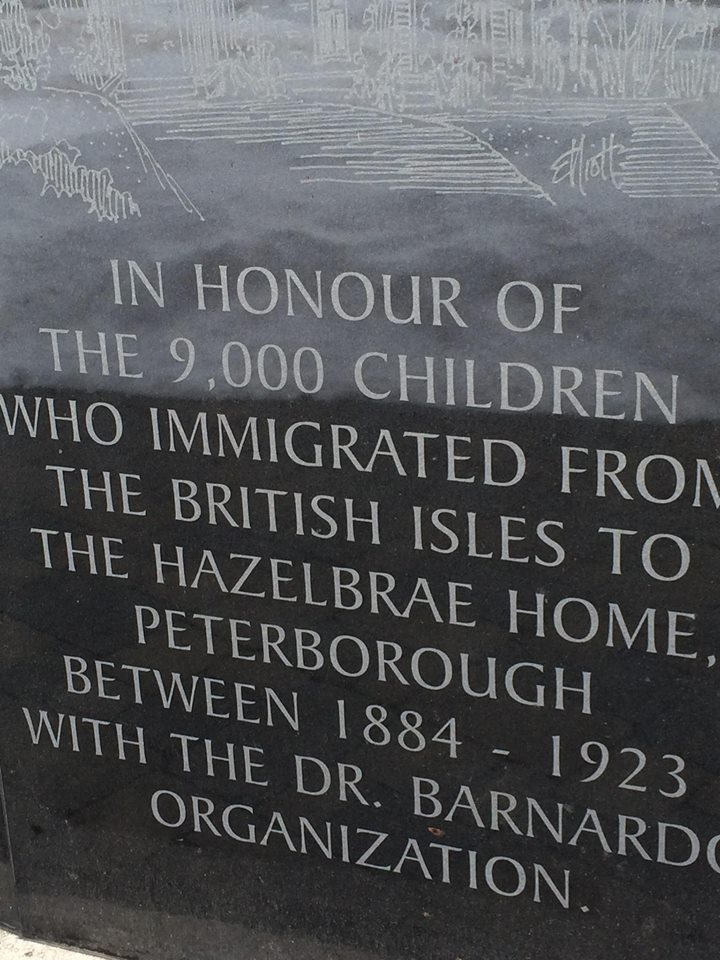Barnardo’s Hazelbrae Home in Peterborough and George Cox
Dr. Barnardo started sending children to Canada in the early 1870s, mainly using the receiving homes set up in Belleville by Annie MacPherson and then Dr. Stephenson in Hamilton. By the 1880s, the numbers of children eligible to emigrate had increased so dramatically, that a Home in Canada was searched for.
In 1883, Barnardo was offered, rent-free, a number of facilities in Peterborough by the then mayor of Peterborough, George Cox. From these, a three story mansion named Hazelbrae was chosen. Cox’s interest had been sparked in Barnardo’s cause while on business in Toronto when he was invited by Barnardo’s Canadian Committee (amongst whom were prominent businessmen S.H. Blake, Q.C. and Sir William Mulock). They met with Alfred Owen, Barnardo’s Canadian superintendant and Frederick Fielder, the Governor of Barnardo’s London headquarters.
Hazelbrae was located at the top of ‘Conger’s Hill’ on five acres of fertile land. The laneway into Hazelbrae ran from George Street and crossed the tracks of the Midland Railway. Young children could be dropped off at the laneway and had an easy hike up the hill. George Cox eventually took over the Midland Railway in 1878 and then leased it to the Grand Trunk Railway. Later it became the Canadian National Railway when the last group of children was received in 1922.
Cox was one of Canada’s most prestigious men. First an insurance agent for Canada Life, he rose quickly in the ranks with the idea of becoming president of the company. He was Mayor of Peterborough for seven consecutive one year terms and though he failed to break through in provincial or federal politics, Cox became a Senator in 1896. In the first decade of the 20th century, his list of directorships expanded to include 46 firms, great and small. Cox was one of the most powerful financiers in Edwardian Canada, a mobilizer and investor of capital. He was involved in insurance, real-estate, banks, railways, books, bicycles and the advancement of electricity at home and abroad (for example, the Brazilian, São Paulo Tramway, Light and Power Company).
A temperance man, Cox was a great supporter of church organizations and the Toronto General Hospital. For many years, he was president of the Ontario Ladies’ College in Whitby, Ont., and bursar of Victoria College, and the Methodist component of the University of Toronto. He also held other philanthropic titles.
After Mayor Cox secured the three-story Hazelbrae for Barnardo, it was renovated into a home capable of housing at least 150 children. The drawing room was converted into a playroom, the kitchen was converted into a dining room with long tables and an annex was added with sufficient sleeping quarters and cots. Indoor toilet facilities were also provided.
By 1889, Hazelbrae became the distribution home for girls, while boys were sent to the Toronto Home. Hazelbrae was renamed the Margaret Cox Home in 1912 in honour of George Cox’s late wife. By the time it ceased operations in 1922, almost 10,000 children had passed through its doors.

The building was demolished in 1939 and in 1941, Dr Barnardo’s Homes in London, England sold the entire property to Morley Shaver of Peterborough.
Today a black granite Heritage plaque stands firmly near the site with the names of the Hazelbrae Barnardo children and the dates they arrived there. These children will never be forgotten thanks to the research and fund-raising efforts of Peterborough’s Ivy Succee, Ottawa’s John Sayers and the Hazelbrae Memorial Group.

